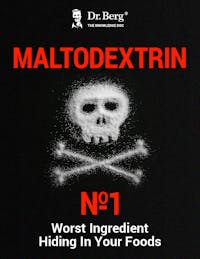The #1 Worst Ingredient in the World (HIDING IN YOUR FOODS)

4 Dangerous Ingredients to Avoid – Wallet Cutout Card
Identify harmful ingredients hidden in processed foods
Learn to recognize and identify these ingredients on food labels
Get a practical wallet cutout for quick reference while shopping or dining out

4 Dangerous Ingredients to Avoid – Wallet Cutout Card
Identify harmful ingredients hidden in processed foods
Learn to recognize and identify these ingredients on food labels
Get a practical wallet cutout for quick reference while shopping or dining out

4 Dangerous Ingredients to Avoid – Wallet Cutout Card
Identify harmful ingredients hidden in processed foods
Learn to recognize and identify these ingredients on food labels
Get a practical wallet cutout for quick reference while shopping or dining out

4 Dangerous Ingredients to Avoid – Wallet Cutout Card
Identify harmful ingredients hidden in processed foods
Learn to recognize and identify these ingredients on food labels
Get a practical wallet cutout for quick reference while shopping or dining out

4 Dangerous Ingredients to Avoid – Wallet Cutout Card
Identify harmful ingredients hidden in processed foods
Learn to recognize and identify these ingredients on food labels
Get a practical wallet cutout for quick reference while shopping or dining out

4 Dangerous Ingredients to Avoid – Wallet Cutout Card
Identify harmful ingredients hidden in processed foods
Learn to recognize and identify these ingredients on food labels
Get a practical wallet cutout for quick reference while shopping or dining out

Maltodextrin – #1 Worst Ingredient Hiding in Your Foods
Discover why maltodextrin is a highly problematic ingredient found in processed foods
Understand the detrimental impact of maltodextrin on metabolic health and weight gain
Learn about hidden sources of maltodextrin and how to spot this harmful ingredient on labels
Explore why the food industry uses maltodextrin extensively and how labeling practices allow it to go unnoticed

Maltodextrin – #1 Worst Ingredient Hiding in Your Foods
Discover why maltodextrin is a highly problematic ingredient found in processed foods
Understand the detrimental impact of maltodextrin on metabolic health and weight gain
Learn about hidden sources of maltodextrin and how to spot this harmful ingredient on labels
Explore why the food industry uses maltodextrin extensively and how labeling practices allow it to go unnoticed

Maltodextrin – #1 Worst Ingredient Hiding in Your Foods
Discover why maltodextrin is a highly problematic ingredient found in processed foods
Understand the detrimental impact of maltodextrin on metabolic health and weight gain
Learn about hidden sources of maltodextrin and how to spot this harmful ingredient on labels
Explore why the food industry uses maltodextrin extensively and how labeling practices allow it to go unnoticed

Maltodextrin – #1 Worst Ingredient Hiding in Your Foods
Discover why maltodextrin is a highly problematic ingredient found in processed foods
Understand the detrimental impact of maltodextrin on metabolic health and weight gain
Learn about hidden sources of maltodextrin and how to spot this harmful ingredient on labels
Explore why the food industry uses maltodextrin extensively and how labeling practices allow it to go unnoticed

Maltodextrin – #1 Worst Ingredient Hiding in Your Foods
Discover why maltodextrin is a highly problematic ingredient found in processed foods
Understand the detrimental impact of maltodextrin on metabolic health and weight gain
Learn about hidden sources of maltodextrin and how to spot this harmful ingredient on labels
Explore why the food industry uses maltodextrin extensively and how labeling practices allow it to go unnoticed

Maltodextrin – #1 Worst Ingredient Hiding in Your Foods
Discover why maltodextrin is a highly problematic ingredient found in processed foods
Understand the detrimental impact of maltodextrin on metabolic health and weight gain
Learn about hidden sources of maltodextrin and how to spot this harmful ingredient on labels
Explore why the food industry uses maltodextrin extensively and how labeling practices allow it to go unnoticed
Maltodextrin is a seemingly innocuous additive that often goes unnoticed on ingredient lists, but it's essential to understand its role and potential impact on our health.
Look at familiar foods high in maltodextrin and learn how this high glycemic sweetener can substantially affect blood sugar levels.
What's the Glycemic Index?
The glycemic index (GI) measures how quickly carbs are absorbed into our bloodstream and spike blood sugar levels.
Foods with high GI values, like white bread or potatoes, cause significant fluctuations in blood sugar levels and trigger excessive insulin secretion that can cause adverse health impacts.
It's essential to understand this principle to comprehend why maltodextrin, despite not being classified as a sugar, can harm our bodies.
Glycemic Index Explained
The glycemic index ranks carbohydrate-containing foods based on how they affect blood glucose levels when eaten alone.
The scale ranges from 0 to 100, with pure glucose having the highest score of 100.
Foods with low GI (55 or less): Whole grains, beans, lentils, etc., digest slowly, leading to a gradual rise in blood sugar levels.
Foods with medium GI (56-69): White rice or raisins cause moderate rises.
Foods with high GI (70+): Bagels or popcorn cause sharp spikes.
Check out this article for further elaboration on understanding and using the glycemic index effectively.

Maltodextrin's High Glycemic Index Value
Maltodextrin stands out because it has one of the highest possible scores on the glycemic index - even higher than table sugar.
This means that consuming maltodextrin causes an almost immediate increase in blood glucose level - similar to what happens after eating simple sugars like candy bars or sugary sodas.
Unmasking Maltodextrin - The Worst Ingredient
While it isn't classified as sugar on food labels, maltodextrin has an incredibly high glycemic index score and thus can have the same damaging effects on our bodies.
Maltodextrin often goes unlabeled as sugar and is used by manufacturers to sweeten products without listing "sugar" on their nutritional information panels.
Manufacturers use this ingredient to sweeten products without having to put "sugar" on their nutritional information panels, leading consumers to believe they're making healthier choices than they are.
For example, you might think you're doing your body a favor by choosing low-fat yogurt over regular yogurt or using Splenda vs. sugar. Still, if maltodextrin is listed among the ingredients, you could unknowingly consume more sugars than in full-fat versions.
It's important always to check product labels and avoid foods containing maltodextrin where possible.
How Maltodextrin Behaves Like Sugar
Maltodextrin behaves much like sugar when ingested.
It's rapidly absorbed into our bloodstream, causing an immediate spike in insulin levels - similar to after consuming high-sugar foods or drinks. This can lead to energy crashes and cravings for more sugary snacks later in the day.
This rapid absorption rate also makes it particularly unsuitable for people with diabetes or anyone trying to maintain stable blood glucose levels, such as those following a ketogenic diet plan.
In addition to raising blood sugar and insulin levels, maltodextrin offers no nutritional value whatsoever - only empty calories.
For more information on the dangers of hidden sugars, check out this article.
Health Implications of Maltodextrin
Maltodextrin, a common ingredient in many foods and supplements, may have more significant health implications than you might think.
Blood Sugar Imbalances
The body quickly absorbs maltodextrin after consumption - much faster than other carbs.
This leads to an immediate rise in blood sugar levels, which can be problematic for those with diabetes or trying to manage their weight.
Rapidly increasing blood sugar levels can cause the pancreas to produce more insulin, leading to a potential risk of developing conditions like insulin resistance and type 2 diabetes.

Nutrient Deficiencies
Beyond impacting your blood sugar levels, maltodextrin has another downside: nutrient depletion.
Regular consumption of maltodextrin products can interfere with absorbing essential nutrients from other food sources. Over time, this lack of nutrient uptake could potentially contribute to crucial vitamin and mineral deficiencies.
Hidden Sources of Maltodextrin
Are you unknowingly consuming maltodextrin every day?
This synthetic carbohydrate is found in many common foods, from natural flavorings to infant formulas, and can harm your health without realizing it.
Dietary Supplements
Believe it or not, many supplements contain hidden carbohydrates like maltodextrin. It's often used as a filler or binding agent due to its neutral taste and quick dissolving properties.
Protein powders, meal replacement shakes, and vitamin tablets are just a few examples of products that could contain this high-glycemic ingredient.
Always read the labels carefully before purchasing any supplement.
Infant Formulas
Maltodextrin isn't just found in adult food products; it's also commonly added to infant formulas.
Manufacturers employ maltodextrin due to its low cost and straightforward production. However, this may lead to infants having early contact with it, potentially causing them health issues in the future, such as obesity or diabetes.
Here are some other common foods where you might find maltodextrin:
Canned fruits
Sauces & salad dressings
Diet snacks
Low-fat foods
Sugar-free foods
Sports drinks
Other Uses of Maltodextrin
Maltodextrin is a versatile ingredient beyond our kitchen cabinets and into various industries.
Its unique properties make it an ideal choice for several applications, not just within human nutrition.
Pet Foods and Beer
Maltodextrin is highly digestible, making it an energy source for animals without the risk of digestive issues.
Moreover, maltodextrin plays a significant role in brewing beers by contributing to the body and mouthfeel of the beverage. Maltodextrins are non-fermentable sugars that add sweetness and body to beers without increasing alcohol content.
The Role Of Maltodextrin In Industrial Applications
Beyond beverages and animal feed, this synthetic carbohydrate finds use in medical applications, too.
For instance, it's used in intravenous nutritional supplements given to patients unable to consume food orally due to specific health conditions.
Studies suggest that such solutions can help maintain blood glucose levels while providing necessary nutrients directly into the bloodstream.
Apart from these uses, maltodextrin acts as a filler material, enhancing volume in many processed foods like instant puddings or gelatine desserts - giving them their characteristic smooth texture.
Additionally, because it absorbs water quickly when mixed with liquids - making them thicker - maltodextrin also has industrial uses like spray drying substances where maintaining moisture content is crucial.
Conclusion
Understanding the glycemic index is crucial for making informed decisions about what we eat, and avoiding the worst ingredient found in many foods - maltodextrin - can greatly benefit our health and well-being.
Maltodextrin can be misleadingly labeled and behaves like sugar in our bodies. It's rapidly absorbed and can lead to excessive insulin levels linked to an increased risk of type 2 diabetes and metabolic syndrome.
Common foods containing hidden maltodextrin include low-fat foods, diet products, supplements, and infant formulas. So, it's essential to be mindful of food labels and avoid processed foods with hidden sugars.
Supporting Data
Previous blog
#1 Early Sign of Toxic KidneysTags

Popular
08/21/2024
55K views
02/23/2025
46.3K views
11/18/2024
277.5K views
03/18/2024
11/21/2022




